375s You Should Know
by Wayne van Zwoll
Best cartridge ever? Holland’s .375 Belted Rimless Magnum NE makes the short list. Here’s why!
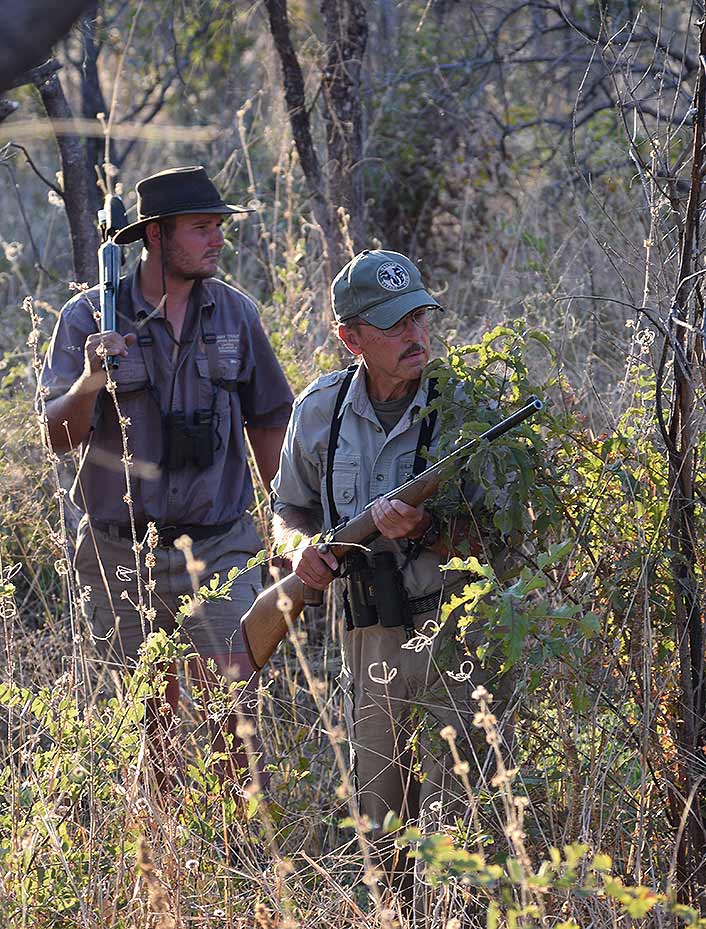
HE WAS following a buffalo, a big bull that the previous day had killed a woman and two children. By all he could deduce, the animal had a broken foreleg and a bullet in the paunch. Neither was a lethal wound. John Taylor knew his task. “A beast like that,” he wrote, “coming at maybe 25 miles an hour and less than 10 yards away … takes a deal of stopping.”
When he saw the bull’s ear flick at a fly, it was in thick brush across a clearing “11 paces wide.” He fired instantly, but even the double’s heavy solid couldn’t keep a straight path through the thorn. The bull recovered and came, full on. “I sank to one knee [and] gave him the left barrel fairly in the centre of his great chest ….” He crashed on his nose, hind quarters in the air, then keeled over, dead.
Such a result might have been expected from a .470 or .500 Nitro Express, adored by professional hunters in the first decades of the 20th century. Development of Cordite and smokeless powders beginning in the 1880s had changed the nature of hunting ammunition. By the onset of the Great War, faster, smaller bullets were replacing the ponderous missiles borne by early African explorers.
In 1840 a 4-bore rifle commissioned by 19-year-old Samuel Baker from George Gibbs fired a 4-ounce (1,750-grain) silk-patched lead bullet in front of 16 drams (437 grains) of black powder. The 21-pounder had 2-groove rifling in a 36-in. barrel. Baker’s hunting exploits would later become the stuff of legend. They blessed with reflected glory the gun shop he came to favor — that established by tobacconist Harris Holland in 1837 and run with his nephew Henry.
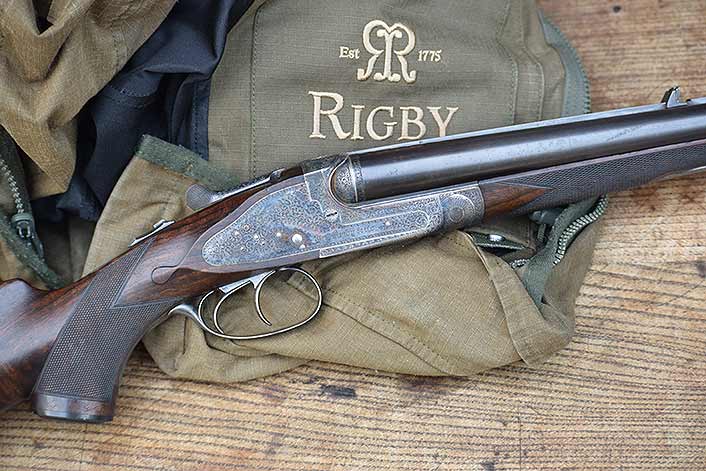
Slave to the laws of physics, black-powder rifles relied on bullet mass to deliver the energy faster, lighter missiles would wring from smokeless loads. Despite their great weight, early big-bore rifles kicked brutally. Three transactions after retiring elephant hunter William Finaughty sold his in 1875, the fourth owner hung 3 pounds of lead up front to keep the barrel down in recoil! More civility came at a price. The .450/400 Black Powder Express load sent 270-grain bullets at only 1,650 ft/sec, landing a softer punch than a modern .45-70 load. Hardly an elephant stopper! Beginning around 1896, Nitro Express cartridges with Cordite powder opened the throttle. Jeffery’s .450/400 3-inch wrung 2,100 ft/sec from heavy bullets, as did many big-bores that followed.
Cordite, a primitive smokeless propellant named for its spaghetti-like form, changed the lexicon of riflemen drawn to east Africa in the halcyon years of the ivory trade. “Large-bore” black-powder rifles were, earlier, those with bores over .600. “Medium-bores” fired bullets .400 to .600 in diameter. “Small- bores” were those under .400. Smokeless shifted the scale. Large bores included rifles 450 caliber and up.
A large medium bore, wrote John Taylor in his book, African Rifles and Cartridges, spanned the range .400 to .440. Medium-bores ran from .318 to .375. Small-bores comprised the rest of the field and were commonly considered adequate only for light game.
When the buffalo bearing down on Taylor dropped “as tho there had been a steel hawser stretched across his path,” the lethal bullet wasn’t a large-bore, but a 300-grain solid from a .375 H&H Magnum, a cartridge praised by Taylor. “In actual practice,” he observed, “the stopping power of the .375 Magnum would seem to warrant a higher classification.”
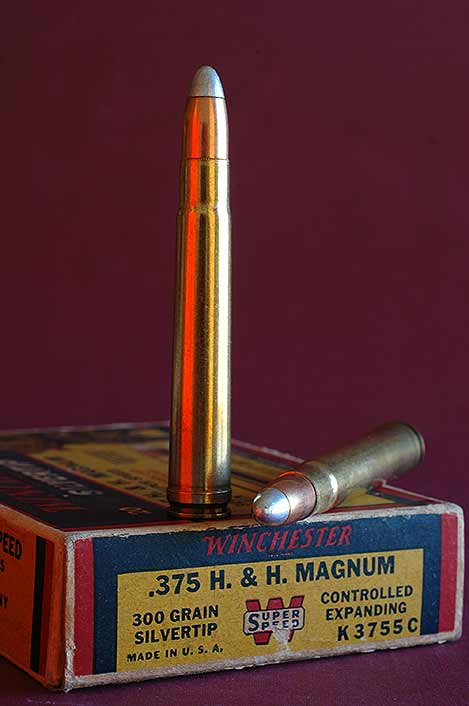
The English gun-making firm of Holland and Holland introduced the .375 Belted Rimless Nitro Express in 1912. Steep case taper and a shoulder angle of less than 13 degrees were said to have prompted the belt in front of the extractor groove, for positive headspacing. The cartridge came Stateside 13 years later, in loadings by Western Cartridge Company, when the case was also necked to form the .300 H&H Magnum. Soon up-scale New York gun-builder Griffin & Howe began barreling Magnum Mauser actions to .375. In 1937 it joined the list of charter chamberings for Winchester’s Model 70. During the ’40s, Roy Weatherby took orders for custom rifles in .375 H&H — albeit Roy’s new magnums included a blown-out version of the cartridge, with minimum taper and radiused shoulders to hike case capacity, and velocities that trump the parent round’s by nearly 200 ft/sec.
Rifles for the .375 H&H must have long actions. The case measures 2.85 inches; loaded length is 3.60. (The .30-06 mikes 2.49 and 3.34.) In 1961 and ’62, Remington listed a Kodiak Model 725 in .375 H&H. The subsequent Model 700 also chambered it — starting at $310, same as Winchester’s 70 African.
It’s no surprise that when Holland’s .375 Belted Magnum appeared a rimmed or flanged version came out for hinged-breech rifles. In 1912 any round that developed two tons of muzzle smash was surely bound for Africa, where double rifles were overwhelmingly favored for dangerous game. While doubles could be fitted to reliably extract rimless cases, hunters of traditional bent preferred the prominent rim. As the Mauser bolt rifles for which the belted round was designed could comfortably bottle higher pressures than did doubles, the .375 Flanged Magnum Nitro Express was tamed slightly. Velocity loss: a negligible 50 to 100 ft/sec. The Flanged round had a slightly longer (3.94-inch) hull, and a loaded length of 3.80.
These were not the only .375s of the day. The original .375 Flanged Nitro Express, introduced in 1899, had a 2.50-inch case and was much less powerful than .375 Flanged and Belted Rimless Magnums. Its 270-grain bullet at 2,000 ft/sec started 600 ft/sec behind the Flanged Magnum. The .400/375 Belted Nitro Express announced by Holland & Holland in 1905 had a belted 2.47-inch hull. It never became popular, and its bullets were said to penetrate poorly. The British also cataloged the .375 Rimless Nitro Express with a 2.25-inch case (on other lists the 9.5mm Mannlicher-Schoenauer). Like the .400/375, it hurled 270-grain bullets at around 2,100 ft/sec.

A .375 often overlooked is the .369 Purdey, a rimmed cartridge dating to 1922. Its 2.69-inch case held enough Cordite to launch 270-grain bullets at 2,500 ft/sec, so it came pretty close to matching the .375 H&H Magnum. But its .616 rim, bigger even than the .572 rim of the Flanged Magnum, suited it only to hinged-breech rifles. Also, the choice of loads was very limited; and like many cartridges then, it was proprietary, designed for rifles built by Purdey. The .369 was generally well thought of as a medium-bore round but was not widely chambered.
The most potent in its class until Weatherby super-charged it, the .375 H&H is not a hard kicker. Most hunters can trigger even an 8½-pound bolt rifle without fear of splitting a lip or mashing their nose with their thumb. Modest recoil in a rifle easy to carry all day endears the .375 H&H even to professional hunters. After an elephant cull in 1985, I interviewed rangers who’d downed 52 pachyderms that day. A shooter who favored his .375 over government-issued .458s said his bullets drove deeper. I had watched him kill an elephant going away. The 300-grain solid struck the animal in the neck, threaded the brain and exited the forehead. “Heavier bullets with more energy have an advantage when you hit on the edges,” the man conceded. “A stunned beast may take longer to recover its senses when struck with a 530-grain solid from a .500 Jeffery or a .505 Gibbs. But it is no more dead if that bullet enters the brain.”

Some years later, I’d have my chance to hunt elephants with a .375. The animal we came upon in thick Zimbabwean jess vanished in a blink. Then it turned, reappearing at 16 steps, towering. The Mauser felt strangely light, as if a balsa replica. I remembered, in that wink of time, to shade low, as the brain lies well back from the fore-skull. The 350-grain Woodleigh solid drove on and on, into the loins. The great beast wilted rear first, a good sign. I dashed ahead, perhaps too fast, and fired an insurance shot.
The original light-bullet load for the .375 H&H, a 235-grain softnose at 2,800 ft/sec, expired early. Few hunters mourned the loss. Its sectional density was too low to ensure penetration in tough game, even if its jacket and core remained intact — which, reportedly, they seldom did. The bullet was destructive in deer-size game, and didn’t match the arc of the 270- and 300-grain missiles a hunter on safari would most often have in his magazine. A 270-grain pointed bullet clocking just shy of 2,700 ft/sec flies as flat as a 180-grain spitzer from a .30-06. That’s flat enough to center the vitals of plains game to 250 yards with a 200-yard zero and a dead-on hold. Inside 150 yards it hits about where you’ll land a 300-grain solid.
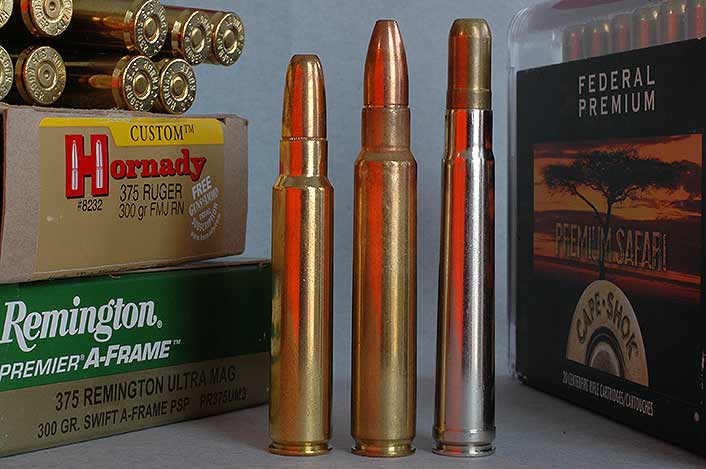
Modern 250- and 260-grain bullets ably complement the traditional 270-grain softpoints standard in .375 ammo for most of a century. Barnes has a 235-grain TSX that does penetrate; Nosler’s 260-grain AccuBond delivers more punch at 200 yards than a 180-grain .30-06 bullet at the muzzle! Bullet-makers can be forgiven, though, for focusing development on heavier missiles. Myriad .30 magnums handily put the skids under game once thought tough enough to require .375-bore softpoints. Eland, for example, and brown bears. But no matter how lethal their punch, these sharp-shouldered wonders can’t replace the .375 in Africa, where rifles of at least .375-bore are commonly mandated for hunting dangerous game. Verily, that’s a reasonable rule. The stopping power of a well-constructed 300-grain solid driven at 2,500 ft/sec from a .375, or a 350-grain at 2,300, is hard for any sub-caliber cartridge to beat! The ubiquitous 9.3×62, whose 286-grain, .366 softs and solids at 2,350 ft/sec have downed an inestimable number of big African animals since its 1905 debut, has been exempted in some areas from this edict.
Jack O’Connor allowed that the .375 was “probably the best all-around cartridge ever designed.” It was, he wrote, the queen of medium-bores, and added that were he to carry one rifle for all the world’s game, it would be a .375. Elmer Keith, who in many cartridge debates contradicted O’Connor, declared the .375 “most reliable” for large animals. “It will also kill the smaller game cleanly, with little waste of meat …. [It] is one fine cartridge that no man can go wrong on.”
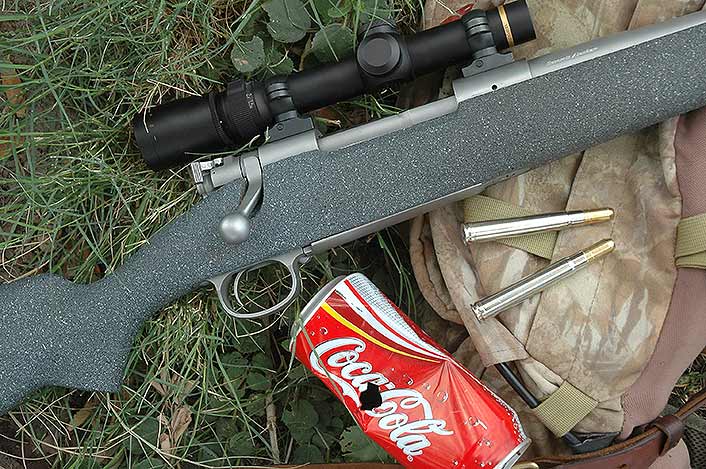
My first .375 was an early Winchester 70 with a split wrist, which I pinned and glued. That rifle still wears the tall brass-bead front sight and Redfield aperture it had on my first safari. Many years later I took up with a Model 1999 Montana rifle in .375, a stainless Summit Alaskan with a synthetic stock that seems too small for my long arms but always puts the sights on target.
A rifle that becomes an extension of hand and eye is one to be treasured. When on the trail of a leopard a few years ago, I kept abreast of trackers as they bent to the sand and wound in a great helix into cover that got increasingly thick. Dense grass and thorn obscured the spoor; the going was slow. Then, suddenly, a yell! I dashed through thorn, shouldered the rifle and swung where the boys pointed, mere feet away. By great good luck, a ray of sun lit a rosette and an ear. My bullet was away instantly. It broke both shoulders. The cat vaulted into the air with a screech, landed hard and died.
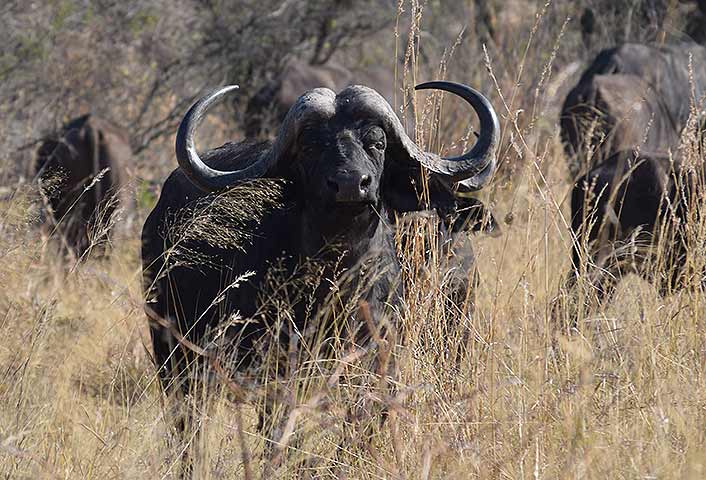
Days later, with the same rifle, I knelt to aim at an eland quartering off across a pan at 250 yards. A long poke. But there was no approach, and the bull was nearing cover. The Federal-loaded, 300-grain Trophy Bonded bullet struck audibly. The great animal staggered and recovered. A second shot brought it down. The bullet entries were half an inch apart.
Perhaps no plains animal more thoroughly tests bullet performance or placement than a giraffe. A big bull can weigh more than two tons, twice as much as a Cape buffalo. And the vitals are not where you think. The lungs lie very high and between, not behind, the shoulders. A hit in the crease is too far back. A giraffe’s long legs and panoramic view will keep you at distance if you must follow to finish the beast.
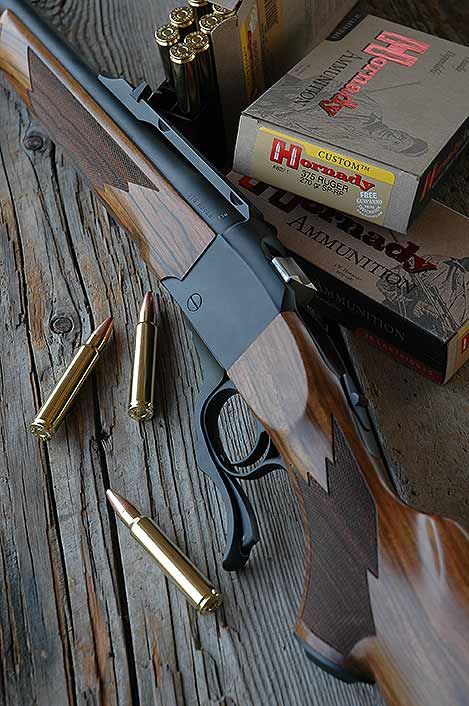
“I don’t wish to kill a giraffe,” I told my PH when he suggested it. Then he explained he needed a dark cape from an old bull. “There’s always a surplus of old bulls. No one wants to shoot them. They live long, with no natural predators. They eat a lot. Biologically, shooting a giraffe can be a good deed.” Okay.
Right away we found that giraffes with no seeming concern for most human traffic learn quickly to avoid hunters sneaking through the bush. When, after hours of hide-and-seek, the giraffe out-walking us turned and gave me a clear shot at 70 steps, I aimed quickly and fired offhand. The great animal lunged away in that deceptive, slow-motion giraffe-lope. He’d barely melted into the tall bush when we heard the crash. My .375 softnose had torn through both lungs.
Hunters who most often fire lighter rifles commonly speak in hushed tones of the .375’s knock-down power. I’m not sure what they mean. Even the most powerful cartridges don’t “knock down” game unless they strike supporting bone. Animals that drop to a shot aren’t knocked off their feet; they’ve lost the ability to stand because the bullet has shattered bone or destroyed the nerves controlling their legs or so damaged vital organs that life is about to leave. The first animal I shot with a .375 Magnum was a big waterbuck rousted in heavy cover. If memory serves, I fired four times with my old iron-sighted 70, fast.
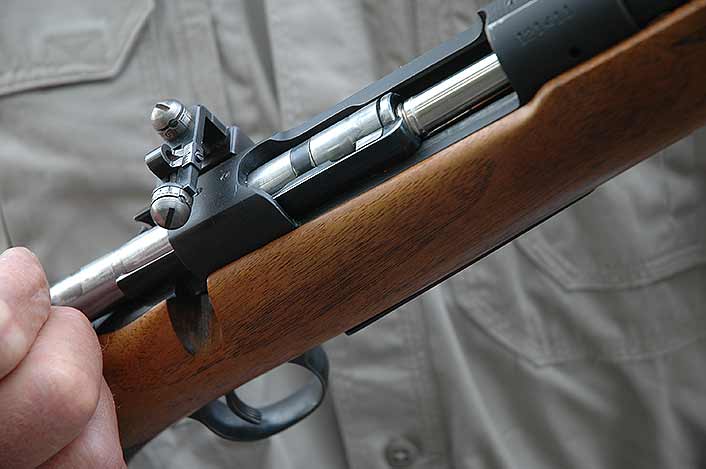
The first hit caused the bull to swing about. He staggered at the second and third, dropped to the fourth.
Stateside, I carried that .375 into elk cover. I was downwind when I heard the clack of antlers, but got careless, and a cow saw me. She stiffened, head up. The clacking stopped. Behind her a yearling bull eased into a slot. The bead settled low in the ribs and 300 grains of lead went there. But instead of turning upside down as I’d expected, the elk wheeled and ran off. I followed and found it dead a few steps on.
At this writing, my most recent .375 kills were a kudu and a bushbuck. Both ran after the hit; both died inside 30 yards. In fact, the only animal I’ve seen drop, lifeless, after taking a .375 bullet was a big warthog I shot through both shoulders at 175 yards. It collapsed because no animal can move well when its shoulders are shattered and vitals between scrambled. A Cape buffalo I hit in the same place did not fall down, but struggled on because this massive bovine still had one functioning shoulder. I followed the Trophy Bonded with a solid that smashed the other shoulder as the bull turned. He fell and died. The .375 is a great killer but does not topple game as a student driver might topple a roadside garbage can.
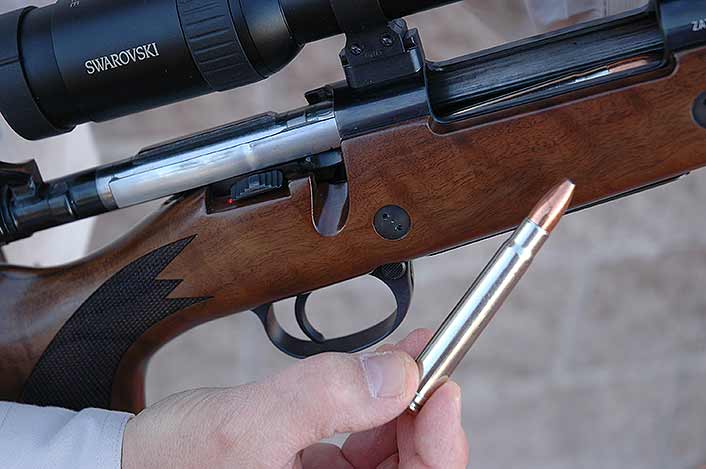
Many fine rifles have been chambered for the .375 H&H Magnum — custom rifles surely, but also factory-built bolt guns like Sako’s 85 Kodiak. Its profile marries easy flow of line with unblinking brawn. The rifle comes to cheek fast and points naturally where I look. The 8-pound heft, I believe, is ideal for a .375, and Sako got the balance right. The shallow V-notch rear sight on the 21-inch stainless barrel pairs with a big hooded white bead, concave so it doesn’t reflect light off-center. Sightline is properly close to that of a low-mounted scope. This Sako’s three-lug bolt has a short but stout extractor and a mechanical ejector. The 3-pound trigger breaks like an icicle. The flush detachable box is cleverly designed to drop easily, but never accidentally. It can be topped off in the rifle through the generous port. My test rifle once cut a .3-inch delta with three Federal 260-grain AccuBonds.
Winchester’s 9-pound Model 70 Safari Express is the current version of the first American rifle barreled to Holland’s famous magnum. It has a Mauser extractor and mechanical ejector. Nicely shaped, cut-checkered walnut graces this rifle. Iron sights, too, of course. CZ’s Model 550 Safari Magnum in .375 H&H gives you Mauser-claw reliability and durability, plus a single-set trigger, folding express sights, a magazine capacity of five. Winchester and CZ rifles currently list for under $1,400, as does the 6¾-pound Browning X-Bolt, the lightest .375 H&H around. X-Bolts have a reputation for fine accuracy. Weatherby’s Vanguard Synthetic makes any list of affordable .375s. It’s a fast-pointing rifle, the stock proportioned for instant aim through its iron sights or a low-mounted scope. The bolt slicks up cartridges reliably, and runs smoothly as a piston. Good trigger too!
At this writing, alas, Remington no longer catalogs a rifle in .375 H&H.
Not long ago quite a few .375s sold for between $2,000 and $2,500. Most have moved to a higher bracket. Kimber’s synthetic-stocked Talkeetna still qualifies. Its walnut stocked sibling, the Caprivi, costs more. Both feature a Mauser-style claw, a three-detent safety. The drool-inducing Dakota 76 boasts very fine walnut and impeccable fit and finish on a frame unabashedly Model 70. Dakota’s round-action 97 is a more affordable alternative but still pricey. Ditto All-Weather and Outfitter Take-Down versions. If the durability of synthetic stocks appeals, consider the PHR from H-S Precision, known for nail-driving rifles built from scratch. The Safari model (add $200 for a left-hand bolt) incorporates a mercury recoil reducer.
One .375 that’s impressed me is the Blaser R8, progeny of the R93. It has a telescoping straight-pull bolt that puts overall length a couple of inches shy of ordinary bolt rifles. In lock-up, a collet engages a circumferential groove in the barrel shank. The bolt-barrel union can endure a thrust of 120,000 psi. A compact magazine nests neatly in the trigger groups. (R8 innards can be removed as a unit without tools.) A flick of your hand cycles the buttery action. A cocking switch replaces the safety. Push up and forward, and you’re set to fire. To de-cock, nudge it ahead and let it return. As it’s not cocked until you’re ready to fire, the R8 can be carried safely with a round up the spout. Plasma nitriding hikes the surface hardness of Blaser’s hammer-forged, interchangeable barrels, with notches for true return-to-zero QD scope rings.
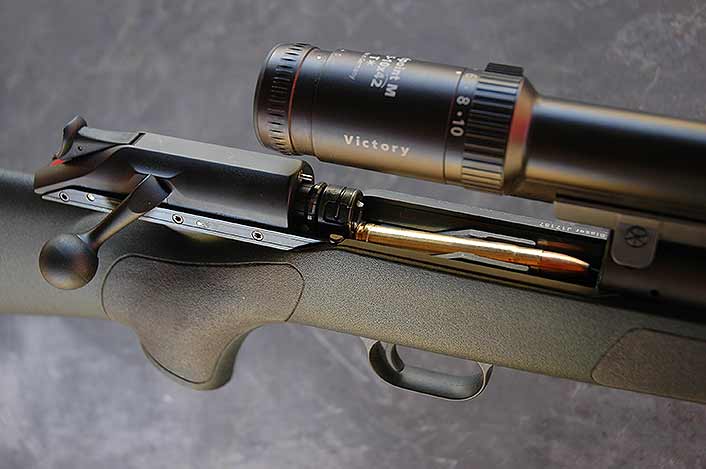
In hinged-breech guns, you’ll find the .375 H&H available in nearly any double you can’t afford. The exquisite dropping-block Miller single-shot from Dakota is another option. I fired one that yielded a memorable .75 group over iron sights! Ruger’s 9¼-pound, Farquharson-based No. 1 Tropical Rifle, and the 7½-pound No. 1 Medium Sporter, are two fine .375 H&H dropping-blocks you’ll have to seek on the used-gun market. The No. 1 has become a limited-production rifle, one chambering per version per year. Ruger’s Model 77 Hawkeye African (walnut stock) and Guide Gun (laminated) come only in .375 Ruger — as do the affordable Mossberg Patriot and Savage Alaskan Brush Hunter.
Among custom-built .375s, I’ve found none better than those from D’Arcy Echols. At the bench one day with a Model 70 Legend rifle under a 3x Leupold, I drilled a .17 group. Yup. Three .375 bullets into one slightly enlarged hole at 100 yards. OK, Lady Luck steadied my hand. And owning such a rifle is a bit like having a 200-mph Maserati in your garage. Still, if you’re as sweet on the .375 H&H as I am, no rifle so chambered is too pretty or too accurate.
You can still get a 98 square-bridge Mausers in .375 H&H. Rigby offers a beauty. The Johannsen Express Rifle is in the same class, with lovely walnut, marvelously sculpted steel and detailed furniture.
These factory loads illustrate the great versatility of Holland’s .375.
250-grain GMX (Hornady Superformance)
| muzzle | 100 yds. | 200 yds. | 300 yds. | |
| velocity, ft/sec | 2,890 | 2,675 | 2,471 | 2,275 |
| energy, ft-lbs | 4,636 | 3,973 | 3,388 | 2,873 |
| arc, inches | -1.5 | +1.7 | 0 | -7.4 |
260-grain Nosler AccuBond (Federal Premium)
| muzzle | 100 yds. | 200 yds. | 300 yds. | |
| velocity, ft/sec | 2,700 | 2,510 | 2,330 | 2,160 |
| energy, ft-lbs | 4,210 | 3,640 | 3,130 | 2,685 |
| arc, inches | -1.5 | +2.0 | 0 | -8.5 |
300-grain Nosler Partition (Winchester)
| muzzle | 100 yds. | 200 yds. | 300 yds. | |
| velocity, ft/sec | 2,530 | 2,316 | 2,112 | 1,919 |
| energy, ft-lbs | 4,263 | 3,572 | 2,970 | 2,452 |
| arc, inches | -1.5 | +2.5 | 0 | -10.3 |
300-grain Hornady FMJ (Hornady Superformance)
| muzzle | 100 yds. | 200 yds. | 300 yds. | |
| velocity, ft/sec | 2,705 | 2,386 | 2,089 | 1,817 |
| energy, ft-lbs | 4,873 | 3,792 | 2,908 | 2,198 |
| arc, inches | -1.5 | +2.3 | 0 | -10.1 |
350-grain Woodleigh FMJ (Norma African PH)
| muzzle | 100 yds. | 200 yds. | |
| velocity, ft/sec | 2,300 | 2,052 | 1,821 |
| energy, ft-lbs | 4,112 | 3,273 | 2,578 |
| arc, inches | -1.5 | 0 | -6.7 |
You might question the high velocity of the Hornady load, as for decades 300-grain bullets were listed at 2,550 ft/sec. New powders have boosted the exit speeds of many loads from the Hornady shop. The relatively modest launch of the 350-grain Woodleigh, on the other hand, belies its haymaker punch.
The advantage of using 300-grain softs over flatter-shooting 270s at 2,700 ft/sec (or, per Hornady’s Superformance load, 2,800), is that you can stagger solids and softs in the magazine without a change in point of impact. When solids aren’t on the agenda, as when you’re hunting big bears or Africa’s biggest thin-skinned game, 270-grain softpoints make sense.
In 1945 a 20-round box of .375 ammo cost $2.83. You’ll pay more now, But the .375 H&H still gives you more options than any other cartridge hurling two tons of energy. And the ammo is dirt-cheap, compared to that for, say, a .505 Gibbs. Figure $140 a box. Of 10.
The Others:
In 1953 Roy Weatherby upstaged his own .375 with a more potent cartridge. The .378 Weatherby Magnum featured a case fashioned from scratch. Instead of the .532 rim and belt trotted out by Holland & Holland in 1912 and since common to the industry, it had a .582 rim, a .603 belt. The hull was .560 at the shoulder and 2.908 inches long. With a 270-grain .375-diameter bullet at a published 3,180 ft/sec, the .378 sent more than 3 tons of energy downrange. A 300-grain bullet left at 2825 ft/sec. This huge cartridge put Roy on the hunt for a rifle action big enough to fire it, resulting in the Weatherby Mark V rifle in 1957.
Incidentally, the .375 Weatherby has returned to the company’s list of chamberings. In my view it’s a more practical round than the .378, when you need more punch than you get from a .375 H&H.
In 1978 Winchester probed new territory with its own .375, on a hull much like the .38-55’s. It’s beefier brass, and a bit shorter. Firing a 200-grain bullet at 2,200 ft/sec, a 250 at 1,900, it handily out-muscled the .30-30 at deer-shooting distances. Winchester chambered it in a new Model 94 Big Bore lever-action, with thicker steel in the rear of the receiver. The .375 Winchester can be fired in .38-55 rifles, but is best kept from early smokeless models and never used in older black-powder-only chambers. While practical in the whitetail woods and adequate for close-cover elk, this .375 never caught on. It was, in appearance and performance, a pre-Depression cartridge, submerged by a tide of small-bore magnums.
In 2000 the Austrian firm of Steyr surprised the industry with its first cartridge in many decades. Developed in collaboration with Hornady, the .376 Steyr was fashioned from the 7×64 Brenneke case for the Steyr Scout rifle, then just two years old. The .376 comes within 150 ft/sec of .375 H&H performance, in a package that fits standard rifle actions. It can drive 270-grain bullets at 2,600 ft/sec, 300s at 2,400.
The path to high-octane rimless rounds had already been probed by Don Allen. His .375 Dakota on the .404 Jeffery case fired a 270-grain bullet at 2,800 ft/sec, matching the later (2010) Blaser Magnum on the .404, and Lazzeroni’s 9.53 Saturn. All three were proprietary rounds. Remington’s rimless .375 Ultra Magnum, announced in 2002, launched 270-grain bullets at 2,900 ft/sec, and 300s at 2,760, from a case the same length as the .375 H&H’s, but with greater capacity.
In 2006 Hornady and Ruger collaborated on a potent .375 to fit standard-length rifle actions. The 2.58-inch .375 Ruger hull has minimum taper, a 30-degree shoulder, about 10 percent more capacity than the .375 H&H. It sends bullets 5 percent faster from a hull .27 inch shorter. Its .532 head is the same size as the Holland’s; but the .375 Ruger has no belt. It registers a higher maximum average pressure (65,000 psi) than the H&H, and uses most powders more efficiently. Hornady’s Mitch Mittelstaedt told me “We wanted the .375 Ruger to deliver from 20-inch barrels what the Holland could in 24-inch.” Hornady lists a 250-grain GMX at 2,890 ft/sec, a 270-grain Interlock at 2,840, a 300-grain DGX at 2,660. Like the .375 H&H the .375 Ruger favors a 1-in-12 rifling twist. At this writing Swift is adding 300-grain softpoint and solid loads for the .375 Ruger to its nascent ammunition line.
Recently I revisited the .375 Ruger in Mossberg’s latest bolt rifle, the Patriot. At about $400, it is one of the most affordable .375s of any kind. But the twin-lug action doesn’t look or feel cheap. The LBA or Lightning Bolt Action trigger on my rifle breaks at a pleasingly light 2¼ pounds. The flush detachable magazine stays put and feeds reliably. The plain walnut stock has classic lines. Neatly stippled panels fore and aft replace checkering. Unlike the “clean” barrels of its stablemates, the .375’s wears Williams iron sights. It’s 22 inches long, unfluted, of medium contour. At 7¼ pounds, this Mossberg is agile! While the well-shaped stock and a ventilated pad tame recoil, you’ll know when this rifle fires! (Other .375 Patriots, with laminated and synthetic stocks, and Marincote and blued metal, scale from 6½ to 7½ pounds.) At the range, under a brilliant Meopta R2 1.7-10×42 scope, I managed to coax three Hornady bullets into one ragged hole. To prove that was no fluke, the Patriot followed with groups almost as small.
Wayne van Zwoll has published 16 books and roughly 3,000 magazine articles on firearms and hunting. Five of his most popular books are: Shooter’s Bible Guide to Rifle Ballistics ($20), Shooter’s Bible Guide to Handloading ($20), Mastering Mule Deer ($25), Mastering the Art of Long-Range Shooting ($30) and Gun Digest Shooter’s Guide to Rifles ($20). Limited numbers are available, autographed, from Wayne at 2610 Highland Drive, Bridgeport WA 98813. Please add $4 shipping.
Stay Connected
- Got a Break in the Montana Missouri Breaks
- It Took Six Days but We Finally Slipped One Past the Bears and Wolves
- No Mule Deer This Fall – Whitetail TOAD!
- An Accounting of Four Idaho Bulls (Elk)
- Arizona Deer Hunt 2019: Good Times with Great Guys
- Caught a Hornady 143 ELDX Last Night
- Cookie’s 2019 Mule Deer Photo Run
- Let’s See Some Really Big Deer
- Alaskan Moose Hunt Success!
- Take a Mauser Hunting: An Important Message From The Mauser Rescue Society!
- Welcome 16 Gauge Reloaders! Check In Here.
- Off-Hand Rifle Shooting – EXPERT Advice
- BOWHUNTING: A Wide One!

